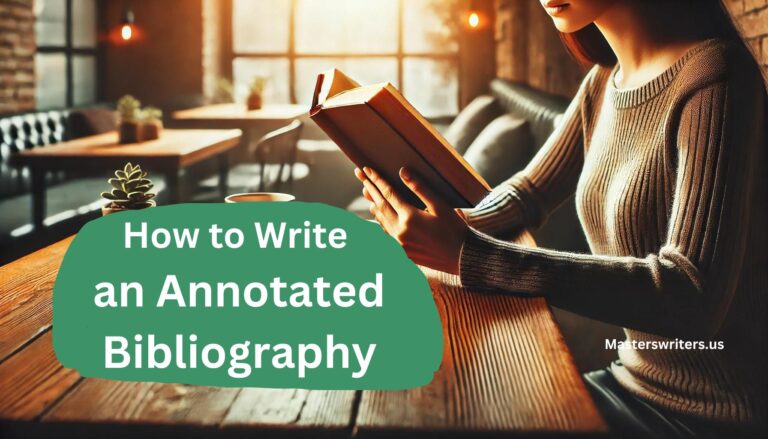Essay Writing Guides
How to Write an Annotated Bibliography: A Complete Guide for Students


So, you’ve come across the term ‘annotated bibliography’ and are probably thinking, “What exactly is this, and how do I even begin?” Don’t worry – you’re not alone! In this article, we’ll simplify everything about annotated bibliographies, making the process as easy as chatting with a friend. Whether you’re a seasoned researcher or a student stepping into the world of citations for the first time, we’ve got you covered. There is no pressure or confusion – just clear steps to help you confidently write your annotated bibliographies. Ready to dive in? Let’s get started!
What is An Annotated Bibliography?
An annotated bibliography is a list of citations to books, articles, and other sources used in research, followed by a brief description or evaluation of each source. Unlike a regular bibliography, which only lists the sources, an annotated bibliography provides additional details about each source’s content, relevance, and credibility. These annotations can summarize the source, assess its value, and explain how it contributes to your research or topic. Annotated bibliographies are often used to help researchers or students evaluate their sources and give readers a better understanding of the depth and scope of the research. They are valuable tools in academic writing, encouraging critical thinking and a more organized research process. Have you already tried our annotated bibliography writing service? This tool helps researchers organize their sources and helps others comprehend the importance and credibility of each source.
What is the Purpose of an Annotated Bibliography?
The purpose of an annotated bibliography is to provide a detailed overview of the sources used in your research. It helps you assess each source’s relevance, accuracy, and quality, ensuring that your research is well-supported. Additionally, it offers readers a deeper understanding of the sources, showing how they contribute to your overall topic or argument. By compiling this information, an annotated bibliography fosters critical thinking and helps organize your research effectively.

Struggling to Write Your Annotated Bibliography
Let our expert writers handle the task for you! Get a professionally written bibliography without the hassle.
What Does an Annotated Bibliography Include?
An annotated bibliography typically includes two main parts: the citation and the annotation.
- Citation: This refers to the source you’re using, formatted according to a specific citation style (such as APA, MLA, or Chicago). It includes the author, title, publication date, and publisher or journal.
- Annotation: The annotation is a summary or evaluation of the source. It can include a summary of the content, assessing the source’s reliability, and how it relates to your research topic. Some annotations may also discuss the strengths and weaknesses of the source or its relevance to your overall argument.
- Evaluation/Reflection (Optional): A critical assessment of the source’s reliability, its relevance to your research, and how it contributes to your topic.
How Long Is an Annotated Bibliography
The length of an annotated bibliography can depend on the guidelines provided by your instructor, the scope of the assignment, or the complexity of your research. Generally, each annotation is about 150 to 200 words, summarizing and evaluating the source. The annotated bibliography could total between 1,000 and 2,000 words for a typical assignment with around ten sources. However, always refer to the specific requirements given, as instructors may have varying expectations for the number of sources, length of annotations, or additional content. Review any provided guidelines to ensure your bibliography meets all necessary criteria. Here is another guide you may want to check about how to write an evaluation essay, which will also give you important insights into academic writing prowess.
How to Write an Annotated Bibliography in 3 Easy Steps.
- Select Your Sources: Gather credible sources relevant to your research topic. Ensure that each source is reliable, up-to-date, and directly contributes to your argument or study. As you collect them, take notes on key points to help with the annotation process later.
- Create the Citation: For each source, format the citation according to the required style guide (e.g., APA, MLA, or Chicago). Be precise with the formatting, ensuring all elements like author names, publication dates, and titles are included correctly.
- Write the Annotation: After citing each source, write a concise annotation summarizing the key ideas and evaluating their relevance and credibility. You can also discuss how the source supports your research, its strengths and weaknesses, or its significance in your field. If you ever find this challenging, request our paper writing help for a quick problem solution.
Annotated Bibliography Examples
APA Annotated Bibliography
Research Article
Sarma, S., Sockalingam, S., & Dash, S. (2021). Obesity as a multisystem disease: Trends in obesity rates and obesity-related complications. Diabetes, Obesity and Metabolism, 23(1), 3-16. https://doi.org/10.1111/dom.14290
Smith et al. (2021) explore obesity as a chronic, multisystem disease, focusing on its rising prevalence and the associated comorbidities. The authors highlight how traditional obesity measures like BMI may fail to predict the risk of comorbidities, underscoring the need for more effective assessments. The article also reviews how obesity complicates conditions such as type 2 diabetes and mental health issues. The authors advocate for improved access to weight loss treatments as a crucial step toward reducing obesity-related complications. This source is valuable for understanding the broader impact of obesity on public health and the barriers to effective treatment.
Book
Stroebe, W. (2022). Dieting, overweight and obesity: Self-Regulation in a Food-Rich Environment. Routledge.
Stroebe presents a social-cognitive approach to understanding weight regulation, focusing on how environmental cues can trigger overeating in chronic dieters. The second edition includes updates on psychological treatments and prevention methods and new chapters on impulse control and the psychological factors influencing weight loss success. This book is a comprehensive review of the field, making it a crucial resource for students, clinicians, and researchers studying obesity, eating behaviors, and weight management. Stroebe thoroughly analyses weight regulation challenges and offers insights into modern prevention and treatment strategies.
Documentary
Jones, T. (2023). Overfed and Undernourished – Examining Obesity and Modern Lifestyles – Health & Wellness [Documentary]. Gravitas Documentaries. https://www.youtube.com/watch?v=5XYbqFDrEco
Jones follows the journey of a young boy, Liam Gollé, as he works to regain his health through lifestyle changes. “Overfed and Undernourished” explores the modern global obesity epidemic by examining unhealthy dietary habits and their long-term effects on physical and mental health. Through Liam’s personal story, the film highlights the role of family support in overcoming obesity and living a healthier life. This documentary is a helpful resource for understanding the real-world impact of obesity and the potential for lifestyle changes to improve health outcomes significantly.
MLA Annotated Bibliography
Journal Article
Al-Subaihi, Mohammad N., and Hanita H. Ismail. “Orwell’s 1984 and the Concept of Powerlessness.” International Journal of English, Literature and Social Sciences (IJELS), vol. 5, no. 1, pp. 289-297.
Al-Subaigi and Hanita explore the theme of alienation in 1984 through Seeman’s concept of powerlessness. The authors focus on Winston’s character and growing alienation caused by totalitarianism, fear, and the Party’s information control. The paper is valuable for readers looking to understand the psychological impact of Orwell’s dystopian society. Its theoretical framework offers a deep analysis of Winston’s sense of powerlessness, making it a valuable resource for scholars studying Orwell’s themes of alienation and control.
Website
Anderson, Stuart. 1984 And George Orwell Live Again In Putin’s Russia. Forbes, 27 September 2023, https://www.forbes.com/sites/stuartanderson/2023/09/27/1984-and-george-orwell-live-again-in-putins-russia/. Accessed 29 September 2024.
Anderson parallels George Orwell’s 1984 and modern-day Russia under Vladimir Putin, highlighting how Orwell’s warnings about totalitarianism still apply. Anderson cites Masha Karp’s book on Orwell and Russia, noting how Putin’s tactics mirror the oppressive measures of the Soviet Union. The article analyses how Orwell’s work remains relevant in today’s geopolitical climate, particularly in the Ukraine conflict. It is a compelling resource for those interested in the real-world implications of Orwell’s dystopian themes.
Book
Howe, Irving. 1984 Revisited: Totalitarianism in Our Century. Harper & Row, 1983
Howe’s book is a collection of essays that examine the political and philosophical implications of totalitarianism as presented in George Orwell’s 1984. It critically analyses Orwell’s work in relation to 20th-century politics, drawing connections to various real-world regimes. This book is an essential resource for readers seeking to explore the broader political significance of Orwell’s novel and its reflections on totalitarianism in modern history.
Final Remarks
Writing an annotated bibliography is an essential skill that enhances your research and critical thinking abilities. It helps you organize and evaluate your sources and ensures that your work is well-supported by credible references. Following the steps outlined and understanding the purpose and structure of an annotated bibliography, you can create a thorough and insightful resource for your research projects. Whether you’re a student or a professional, mastering this technique will significantly improve the quality and depth of your academic work. Take your time, choose reliable sources, and let your annotations reflect your understanding of the material.

Feeling Overwhelmed by Annotated Bibliographies?
Leave the hard work to us and focus on what matters most. Let a professional writer take it from here!
FAQs
How do you write an annotated bibliography?
First, to write an annotated bibliography, gather your sources and format them according to the required citation style (APA, MLA, etc.). Then, for each source, write an annotation summarising the content, evaluating its credibility, and explaining its relevance to your research. Each annotation typically includes a summary, assessment, and reflection on the source.
What are the 3 parts of an annotated bibliography APA?
In APA format, an annotated bibliography typically includes three parts:
- Citation: A properly formatted reference to the source (e.g., author, title, publication date).
- Summary: A brief overview of the source’s key points.
- Evaluation/Reflection: A critical assessment of the source’s reliability, its relevance to your research, and how it contributes to your topic.
Is an annotated bibliography a summary?
An annotated bibliography is more than just a summary. While it includes a brief summary of each source, it also evaluates its credibility, relevance, and usefulness in the context of your research. Additionally, it may reflect on how the source contributes to your overall argument or research question.
How long is an annotated bibliography example?
The length of an annotated bibliography can vary depending on the assignment’s requirements. Each annotation is typically 100-200 words long, which includes a summary, evaluation, and reflection on the source. For example, if you are required to annotate 10 sources, the total length may range between 1,000 and 2,000 words. Always check your instructor’s guidelines for specific length requirements.

